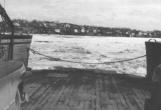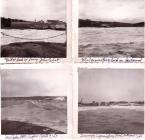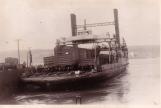14
FERRY BOAT SERVICE OPERATED YEAR ROUND THOUGH ICE WAS A PROBLEM - The Strait of Canso separates Cape Breton Island from mainland Nova Scotia and links the Gulf of St. Lawrence with the Atlantic Ocean.... During the winter, the ice that forms in the Gulf of St. Lawrence is carried down by the current and lodges all around the coast. George's Bay is frozen over and the northern section of the Strait is covered by a solid bridge of ice. For the most part, from the middle of January until the third week of April ocean navigation is completely interrupted though ferry boat service is continued... South of Mulgrave and Port Hawkesbury, the ice moves in both directions according to tidal flow and has not much chance to form an ice bridge. This movement of ice cakes up and down the channel makes the navigation of ferry boats difficult."(Dept. of Mines and Technical Surveys,Geographical Bulletin, No. 3,1953)16
BREAK UP OF ICE BY APRIL - "Ice breaks up first in the Northumberland Strait and moves north westward between Prince Edward Island and the coast of Nova Scotia; then the ice in Georges Bay breaks up and moves first northward and then southward. On one day the whole bay might be clear, but on the next day might be covered over again by southward moving ice on alternate days. Usually the ice packs escape through the Strait of Canso........It is only in the third week of April that the Strait is definitely clear of ice and declared open to (general) navigation until the following January."(Dept. of Mines and Technical Surveys,Geographical Bulletin No.3,1953)18
TOPIC OF FIXED LINK - The topic was still discussed in Board of Trade meetings but the only progress was to add another train ferry, the Scotia II. The crossings and delays had increased at the Strait of Canso due to more productivity for war materials needed from Cape Breton's coal and steel industries. There was no real action between the wars but still a keen interest in Industrial Cape Breton for a permanent crossing at the Strait of Canso.20
TRAIN FERRIES DURING WORLD WARS - Already obsolete as a peace time transportation link, the Scotia ferries revealed their weakness even more during the First Great War,1914 - 1918 and World War II, 1939 -1945. The delays of getting coal from Glace Bay, Sydney Mines and New Waterford, and steel from Sydney needed by the industrialists in Upper Canada for the war effort across the Strait of Canso bottleneck was a major problem. There was also a genuine concern that the Scotias might be sunk by German submarines in the Strait.21
Ice in Strait of Canso.. ferry approaching Port Hawkesbury.1950
Strait of Canso, Nova Scotia, Canada

22
LOOKING FOR SOLUTIONS ICE CONDITIONS RECORDED IN 1941- The problem of huge ice and strong tides in the Strait of Canso was an issue to those responsible for getting people and products across the Strait of Canso. According to an Engineer's Field Book (dated between March 24 and April 24, 1941, found at the Gut of Canso Museum and Archives), ice conditions at the Point Tupper ferry dock and at the proposed site for a motor car ferry at Embree's Point were recorded and pictures taken.Poor weather conditions sometimes completely shut down the ferries due to ice or tides or both.
24
A STRONG ORGANIZATION WAS NEEDED - The Canso Crossing Association was formed in 1948, when the Associated Boards of Trade and other groups lobbying for a link at the Strait of Canso pooled their resources and decided to take a unified approach. "The Association's principle aim is to impress on the appropriate federal authority the necessity for either a bridge, a causeway or a tunnel across the Strait of Canso, N.S." (Dec. 23rd,1948 A Permanent Crossing over the Strait of Canso)Executive from left, seated: T.J. Currie, Ed Corbett, M.R. Chappell, W.D. Carmichael and W.S. Wilson. Standing: George O. Fraser, John C. MacMillan, Russell Urquhart, Johnston Chew, Rev. George MacLean, Gordon Elman, James G. Hackett and L.J. Doucet. Executive members not shown: Freeman Jenkins, I.N. MacLean, John. C. Holder, Tom McLachlan, Dr. Donald J. MacNeil, Dr. H.J. Devereau, Bert MacLeod, Sid Oram and H.D. Adamson.
26
CANSO CAUSEWAY ASSOCIATIONINDUSTRIAL CAPE BRETONERS ORGANIZED - Comprised of elements from several groups, most of which, if not all, were in the Industrial Cape Breton area, The Canso Crossing Assocation was formed as a non political, impartial pressure group. "It is the Association's purpose to lead and co ordinate the efforts of all those sympathetic to this project as a paramount factor in developing freer trade, in the advancement of industry, the promotion of employment and the establishment of better understanding between the people of Cape Breton and their fellow Canadians". (A Permanent Crossing over the Strait of Canso, Dec.23rd, 1948 )
The Canso Crossing Association handled all correspondence with the government from the point of its inception. Between the time of its creation in 1948 and February 1949 when the appointed board of engineers finished their study, the Canso Crossing Association took care of electing a board and launching a public relations campaign.





